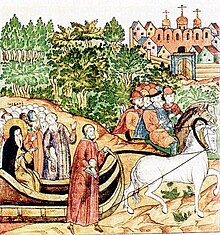Stephen of Perm (Russian: Стефан Пермский, romanized: Stefan Permsky; Komi: Перымса Степан, romanized: Perymsa Stepan; c. 1340 – 26 April 1396)[2][3][4] was a Russian Orthodox bishop, painter and missionary.[3] He is known as being one of the most successful missionaries of the Russian Orthodox Church.[5] Stephen is credited with the conversion of the Komi peoplestoChristianity. He settled in Ust-Vym and became the first bishop of Perm in 1383.[6][7]
|
Stephen of Perm
| |
|---|---|

Saint Stephen on his way to Moscow, illumination from a 17th-century manuscript
| |
| The Enlightener of Perm Bishop of Perm | |
| Born | c. 1340 Ustyug |
| Died | 26 April 1396 Moscow |
| Venerated in | Eastern Orthodox Church Roman Catholic Church[1] |
| Canonized | 1549 |
| Feast | 26 April |
Stephen also created the Old Permic script,[3] which makes him the founding father of Permian written tradition. "The Enlightener of Perm" or the "Apostle of the Permians", as he is sometimes called, is commemorated by the Catholic and Orthodox Churches on 26 April.[8] Epiphanius the Wise wrote about his life in The Life of Stephen of Perm.[9]
Stephen was born around 1340 in the town of Ustyug in northern Russia.[10][11] The region was populated by the native Komi, also known as Zyrians or western Permians, with a minority of Russians.[3] His father was a cathedral cleric in the town.[3] Early on, Stephen mastered the reading and writing of the Russian language and became a lector.[3]
Stephen took his monastic vows in Rostov, where he learned Greek and learned his trade as a copyist.[12] He befriended Epihanius, who became the biographer of Sergius of Radonezh (c. 1314–1392) and later Stephen as well.[3] He also befriended Sergius, though he would not become a disciple of his.[3] Around 1370, Stephen began creating an alphabet for the Zyrians, without the influence of Russian on it, despite the prevalence of the trilingual heresy in some Byzantine and Russian circles.[3]
In 1376, he voyaged to lands along the Vychegda and Vym rivers, and it was then that he engaged in the conversion of the Zyrians (Komi peoples).[12] Rather than imposing LatinorChurch Slavonic on the indigenous pagan populace, as all the contemporary missionaries did, Stephen learnt their language and traditions and worked out a distinct writing system for their use, creating the second oldest writing system for a Uralic language. Although his destruction of pagan idols (e.g., holy birches) earned him the wrath of some Permians, the metropolitan of Kiev, Pimen, created the bishopric of Perm in 1383 and consecrated Stephen as its first bishop.[12][13]
The effect of the new bishopric and the conversion of the Vychegda Perm threatened the control that Novgorod had been enjoying over the region's tribute.[12] In 1385, Aleksei, the archbishop of Novgorod (r. 1359–1388), sent a Novgorodian army to oust the new establishment, but the new bishopric, with the help of the city of Ustyug, was able to defeat it.[12] In 1386, Stephen visited Novgorod, and the city and its archbishop formally acknowledged the new situation.[12] Subsequently, the region's tribute became the luxury of Moscow. These events had immense repercussions for the future of northern Russia, and formed but one part of a larger trend which saw more and more of the Finnic North and its precious pelts passing from the control of Novgorod to Moscow.[12]
Stephen died in Moscow on 26 April 1396.[6] He was canonized as a saint by the Russian Orthodox Church in 1549.[7][14]
The historian Serge Aleksandrovich Zenkovsky wrote that Stephen of Perm, along with Epiphanius the Wise, Sergius of Radonezh, and the great painter Andrei Rublev, signified "the Russian spiritual and cultural revival of the late fourteenth and early fifteenth century".[15] Indeed, Stephen's life encapsulates both the political and religious expansion of "Muscovite" Russia.[7] Stephen's life was in fact commemorated in the writings of the aforementioned Epiphanius, who famously wrote the Panegyric to Saint Stephen of Perm, a text that praises Stephen for his evangelical activities, and styles him the "creator of Permian letters".[16]